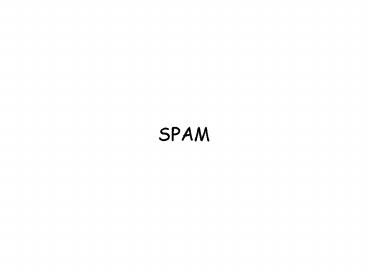SPAM - PowerPoint PPT Presentation
Title:
SPAM
Description:
Overview - San Jose State University ... spam – PowerPoint PPT presentation
Number of Views:46
Avg rating:3.0/5.0
Title: SPAM
1
- SPAM
2
Problem Description
- Develop a tool to send email with phony SMTP
headers to simulate SPAM. - Latest initiatives to reduce SPAM
3
Email Protocols
- Simple Mail Transfer Protocol (SMTP) Transfer
mail reliably and efficiently. Used to send
emails between 2 SMTP servers (mail transfer
agents) - Post Office Protocol (POP) or Internet Message
Access Protocol (IMAP) Retrieve mail from SMTP
servers to email client (mail user agent)
4
Email Flow illus Protocols
- Delivery initiated by transfer of message to
SMTP server - Bases on domain of recipient, SMTP server queries
DNS server for the name of destination SMTP
server - If recipient account exists on destination
server, email is tranferred - If destination server cannot be contacted, mail
transferred to an intermediate relay server. This
will transfer to dest or other relays
5
Differences IMAP/POP
6
SMTP Protocol
- Simple ASCII Protocol (protocol that transmits
only ASCII characters and uses ASCII control
codes. Demands little, if any, error checking).
SMTP service runs on port 25. - No authentication to send email, only to retrieve
(POP)
7
Run SMTP via telnet
Client initiates connection (telnet cs.sjsu.edu 25), No login/password reqd Greeting - 220 eniac.cs.sjsu.edu ESMTP Sendmail 8.12.10/8
HELO request, waits for resp. Quits if server refuses Returns status code and text
MAIL FROM request Returns status code, 250 for success, 500 for failure
RCPT TO request Returns status code
DATA request Returns status code
QUIT request Disconnects
8
Program
- Implementation of SMTP protocol. Uses socket
communication - No login/passwd. cs.sjsu.edu as server
9
Program Output
- The From, To and originating PC name fields are
received correctly. - IP address of PC still visible. Procedure to hide
IP involves manipulating data at network layer
instead of application. Sendmail daemons (UNIX)
used to forge IPs. No conclusive evidence on
checking source code
10
Hide IP in SMTP headers
- Open relay (insecure relay/third-party relay) is
an SMTP e-mail server that allows third-party
relay of e-mail messages (process emails neither
for/from local user). Unaware owner donates
network and computer resources to the sender's
purpose. So, cs.sjsu.edu was used as an open
relay in previous example. - A blind relay is a relay that hides (modifies)
the IP address of the sender and relays the
message to destination
11
Scenarios to Hide IP
- Spammer buys service from Blind Relay service
provider to relay his emails - Spammer sends bulk emails via ISP server to Blind
Relay Host - Blind Relay Host forges SMTP headers, modifying
the IP addresses/hostnames of spammer and his ISP - Blind Relay forwards the emails to destination or
to the next relay host. The destination host
thinks that the emails originated from an
untraceable server. Relay host server claims it
has been spammed.
12
How to reduce SPAM?
- Filters Text based
- Turing Tests CAPTCHA (Visual/Audio)
- Sender Pays - The Penny Black Project
13
Penny Black Project
- Penny Black stamp reformed British postal system
in 1830s. Before this, postage was paid by
addressee and calculated for each letter. After
Penny Black, cost of postage shifted to sender.
14
Computational Spam Fight
- "If I don't know you, and you want to send me
unsolicited mail, then you must prove to me that
you have expended 10 secs, just for me and just
for this message." Spose, effort may be in terms
of CPU cycles. With 80,000 secs/day and 10
secs/msg, spammer restricted to 8,000
msgs/server/day. More investment on servers reqd
to generate current traffic (biggest spammers
send 250 mil/day). - User Experience
- Automatically and in the background
- Checking proof extremely easy
15
Economics
- (80,000 s/day) / (10s/message) 8,000 msgs/day
- Hotmails billion daily spams
- 125,000 CPUs
- Up front capital cost just for HM circa
150,000,000 - The spammers cant afford it.
- Sites like Amazon unaffected as it will add
fraction of a penny to total cost/per order - Circa 300 people total very top few spammers
make a few million/year (F. Krueger, SMN also,
see the recent articles about Alan Ralsky) - Comparison FastClick, with 30 of popunder
market, has profit of 2 mil/yr (income of 4
mil/yr)
16
Cryptographic Puzzles
m, f(S,R,t,nonce)
Sender client S
Recipient client R
- Hard to compute f(S,R,t,nonce)
- lots of work for the sender
- Easy to check z f(S,R,t,nonce)
- little work for receiver
- Parameterized to scale with Moore's Law
- easy to exponentially increase computational
cost, while barely increasing checking cost
17
Memory Bound Puzzles
- Slow CPUs are a lot slower than the fastest
- Factor of 10 30 within desktops
- Memory latencies vary little
- factor of 3
- So design a puzzle leading to a large number of
cache misses - Equalizes actual computation time
18
Ticket Server
- (Ideal Message Flow)
- Ticket kit (, puzzle)
- Ticket (, response)
- Tickets may be accumulated in advance
(pre-computation). - Centralization eases updates
Recipient Server
MSG Ticket
19
Conclusions
- Computational spam-fighting No money is
charged, No challenge-response mechanism, Control
of mail servers remains as it is now, no
infrastructure change - four Stanford students
implemented the scheme. Once in place, virtually
no maintenance - Who chooses f?
- One global f? Who sets the price?
- How is f distributed (ultimately)?
- Global f built into all mail clients? ISPs?
- Awkward Introductory Period
- Old versions of mail programs bounces
- Very Slow/Small-Memory Machines
20
References
- http//www.faqs.org/rfcs/rfc2821.html
- http//whatis.techtarget.com/definition/0,,sid9_gc
i782509,00.html - http//www.codeguru.com/Cpp/I-N/internet/
- http//www.insecure.org/sploits/sendmail.helo.over
flow.html - MSDN Library Penny Black Project































